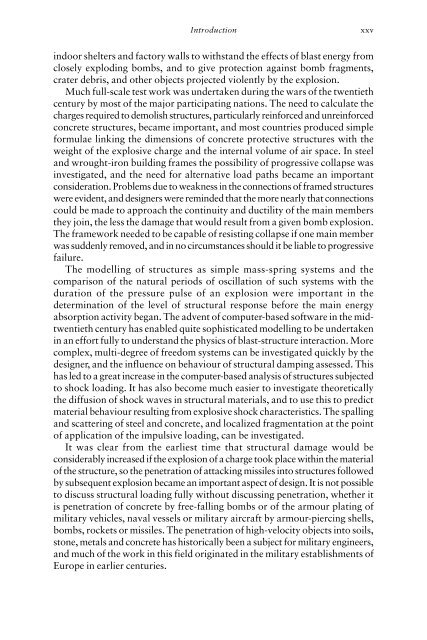A History of Research and a Review of Recent Developments
A History of Research and a Review of Recent Developments
A History of Research and a Review of Recent Developments
You also want an ePaper? Increase the reach of your titles
YUMPU automatically turns print PDFs into web optimized ePapers that Google loves.
Introduction xxv<br />
indoor shelters <strong>and</strong> factory walls to withst<strong>and</strong> the effects <strong>of</strong> blast energy from<br />
closely exploding bombs, <strong>and</strong> to give protection against bomb fragments,<br />
crater debris, <strong>and</strong> other objects projected violently by the explosion.<br />
Much full-scale test work was undertaken during the wars <strong>of</strong> the twentieth<br />
century by most <strong>of</strong> the major participating nations. The need to calculate the<br />
charges required to demolish structures, particularly reinforced <strong>and</strong> unreinforced<br />
concrete structures, became important, <strong>and</strong> most countries produced simple<br />
formulae linking the dimensions <strong>of</strong> concrete protective structures with the<br />
weight <strong>of</strong> the explosive charge <strong>and</strong> the internal volume <strong>of</strong> air space. In steel<br />
<strong>and</strong> wrought-iron building frames the possibility <strong>of</strong> progressive collapse was<br />
investigated, <strong>and</strong> the need for alternative load paths became an important<br />
consideration. Problems due to weakness in the connections <strong>of</strong> framed structures<br />
were evident, <strong>and</strong> designers were reminded that the more nearly that connections<br />
could be made to approach the continuity <strong>and</strong> ductility <strong>of</strong> the main members<br />
they join, the less the damage that would result from a given bomb explosion.<br />
The framework needed to be capable <strong>of</strong> resisting collapse if one main member<br />
was suddenly removed, <strong>and</strong> in no circumstances should it be liable to progressive<br />
failure.<br />
The modelling <strong>of</strong> structures as simple mass-spring systems <strong>and</strong> the<br />
comparison <strong>of</strong> the natural periods <strong>of</strong> oscillation <strong>of</strong> such systems with the<br />
duration <strong>of</strong> the pressure pulse <strong>of</strong> an explosion were important in the<br />
determination <strong>of</strong> the level <strong>of</strong> structural response before the main energy<br />
absorption activity began. The advent <strong>of</strong> computer-based s<strong>of</strong>tware in the midtwentieth<br />
century has enabled quite sophisticated modelling to be undertaken<br />
in an effort fully to underst<strong>and</strong> the physics <strong>of</strong> blast-structure interaction. More<br />
complex, multi-degree <strong>of</strong> freedom systems can be investigated quickly by the<br />
designer, <strong>and</strong> the influence on behaviour <strong>of</strong> structural damping assessed. This<br />
has led to a great increase in the computer-based analysis <strong>of</strong> structures subjected<br />
to shock loading. It has also become much easier to investigate theoretically<br />
the diffusion <strong>of</strong> shock waves in structural materials, <strong>and</strong> to use this to predict<br />
material behaviour resulting from explosive shock characteristics. The spalling<br />
<strong>and</strong> scattering <strong>of</strong> steel <strong>and</strong> concrete, <strong>and</strong> localized fragmentation at the point<br />
<strong>of</strong> application <strong>of</strong> the impulsive loading, can be investigated.<br />
It was clear from the earliest time that structural damage would be<br />
considerably increased if the explosion <strong>of</strong> a charge took place within the material<br />
<strong>of</strong> the structure, so the penetration <strong>of</strong> attacking missiles into structures followed<br />
by subsequent explosion became an important aspect <strong>of</strong> design. It is not possible<br />
to discuss structural loading fully without discussing penetration, whether it<br />
is penetration <strong>of</strong> concrete by free-falling bombs or <strong>of</strong> the armour plating <strong>of</strong><br />
military vehicles, naval vessels or military aircraft by armour-piercing shells,<br />
bombs, rockets or missiles. The penetration <strong>of</strong> high-velocity objects into soils,<br />
stone, metals <strong>and</strong> concrete has historically been a subject for military engineers,<br />
<strong>and</strong> much <strong>of</strong> the work in this field originated in the military establishments <strong>of</strong><br />
Europe in earlier centuries.


